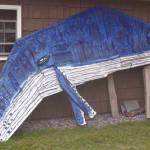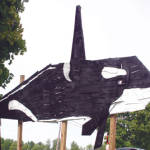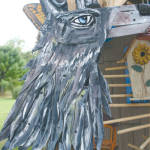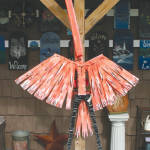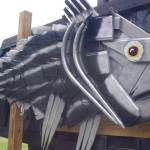Steven Brooks
By Wayne E. Rivet
Staff Writer
NAPLES — When Steven Brooks saw a pile of discarded wood shingles behind the family home, he saw an “opportunity.â€
From the junk pile came colorful and interesting fish, whales, loons, dragonflies and even pink flamingos. His unique art pieces have caught the eyes of travelers along Route 35 in Naples this summer.
“I like to make art work that isn’t too deep or heavy to get into. I like to make pieces that people find interesting, yet also quite simple — like a big whale,†he said. “It’s really cool to take these shingles, that would appear to be junk, and create something that people find interesting and fun.â€
He is thoroughly enjoying his present medium, using wood shingles.
“The materials I am currently working with are fun because it’s recycling — Go Green,†he said.
Steven realized art was his talent at an early age.
“All through school, starting at Songo Locks up through the high school, I always had ‘that’ (art talent). There weren’t many people who had ‘that.’ I always seemed to have the role of drawing things up for people,†he said.
High school art teachers Sandy Arris and Linda Dillon were very influential in Steven developing his art skills and self-confidence to pursue the talent at the college level.
“Through their encouragement, I knew I had to go to an art school,†he recalled.
Steven didn’t take his SAT, which is a prerequisite for most college applications, because he overslept and missed the Saturday test date. So, he went on the Internet, typed in “art colleges that don’t require SATs†and the first school listed was Ringling School of Art and Design in Sarasota, Fla. Steven snapped digital photos of his work, e-mailed them to the school, and was accepted.
Initially, he enrolled in the Illustration program based on his sketch work during his high school days.
“I never really dipped too much into three-dimensional. I had played with clay, but not too much. When I was a little kid, my mom gave me pipe cleaners and I would make all kinds of things with them,†he said. “My mom (Dian) was a strong influence. She painted on sweatshirts and had her own shop. It seemed she was always finding wooden things to paint on. It’s ironic to see what I am doing today, and what she was doing back then. If it wasn’t for what she did, I might not be doing what I am today.â€
Quickly, Steven changed his direction.
“That first year, you really don’t know what you want to do. In the studio classes, we were told to draw things as close as possible to the item before us. There wasn’t a lot of room for creativity. People were being chiseled to make cards for Hallmark. I didn’t want that,†he said.
Steven remembers leaving one instructor shaking his head and a little upset when he used crayons for an assignment. Through high school, Steven enjoyed working with the 60 colors inside the Crayola box.
“It’s fast. I can put it on the paper and don’t have to wait for it to dry. It’s a great medium to work in,†he said. “My professor, however, didn’t think so. I could tell he was boiling inside.â€
Pieces were lined up in the classroom, and then critiqued. Steven placed his piece to the far left, and as luck would have it, the professor went left first.
“He didn’t like it, and I got a ‘C,’†he said.
Sensing he needed to be in a field that would let his creative nature flourish, Steven changed programs to Fine Arts. There, he could let his imagination run wild.
“Their approach was ‘here is what you have, now let’s see what you can do with it.’ They left it open to experiment. I like that out-of-the-box, free roam approach,†Steven said. “It really appealed to me.â€
Allowed to pursue two majors, Steven selected welding. His first piece was a rhinoceros’ head made from a brace that held a spare tire in place under a car.
“I had so much fun doing that piece. I don’t know where that piece is now. I left it in Florida because it was too heavy and too expensive to fly home,†he said.
During his school days, Steven gained an appreciation for using materials that no one wanted. Living on a tight budget, he lacked the financial means to buy “new,†so he was always searching for items others considered junk.
“I developed this ability to work with what I have available to me,†Steven said. “It makes you appreciate what you’re working with more. That reflects on the finished product. If you are passionate about what you are making, the end product will be more polished. People who go out and buy their materials will tip-toe around what they do with it because in the back of their head, they’re thinking price tag and they don’t want to mess it up. When I’m working, I’ll take more chances because I’m using materials no one wants. If I make a mistake, I’ll look for more. It puts more of me into it.â€
Steven’s mother, Dian, warns family members and friends that if they want to hold onto something, keep it away from the young artist.
“I remember taking her plant holder and making a monkey out of it,†he recalled. “She told me she was going to hang them in the house. I told her I needed arms for my monkey.â€
What people may see as junk, Steven sees as possible art sculpture. He took an old bicycle, and made it into a stork. On a recent return trip from Boston, he drove by a steel yard full of junk metal.
“I told my girlfriend, ‘If I had just a truck load of that steel, I’d have enough material to work on for two years’,†he said. “Just glimpsing at those two huge mounds, I could see so much potential.â€
Current inspirations
Today, Steven Brooks is using the old wood shingles to create colorful bass, stately eagles, eye-catching whales and whatever idea pops into his head.
“With the first couple I did, I took the same approach when my drawings. I take a pencil, draw it out, take a Sharpie to get those lines in stone, and then go in with crayons to give it color,†he said.
First, Steven builds a rough frame, again using whatever pieces he finds at his disposal. Then, he shapes and attaches the shingles to the frame. The pieces come to life when Steven adds vibrant colors, of course depending upon what a customer has requested (as seen in the Page 1 bass photo).
Always up for an artistic challenge, Steven went “big†when he tackled creating a blue humpback whale. Once the outline was constructed, Steven researched what “markings†the whale has, thus creating a realistic model of the ocean king. The whale measures out at 19 feet, but is relatively light weight. Once he completed the blue whale, Steven remained in his “big†project mode.
He turned his attention to the Orca killer whale, which is seven inches bigger than the humpback. The whale art was a big hit at this summer’s Naples Arts Festival.
“It was a real eye catcher,†Steven said. “I started with fish that were four-feet long, and now I’m making a humpback whale that is 19-feet long. Where can I go from there? That’s the exciting thing for me. I’m at a point that I have this wonderful feeling that I can make anything I want with whatever I have. It makes me less nervous as to what is ahead. For me, it’s always been that I get an image in my head — a rough idea of how I want something to look — and it works its way to my hand, giving birth to my vision.â€
Steven tries not to pay attention to what “things should look like,†but instead tries to follow his own idea “what I want it to look like,†which may be more in tune with what others think. He is quite versatile. Customers have requested a variety of art figures from pink flamingos, sea horses and loons to dragonflies.
“When someone suggested a dragonfly, I thought, ‘I can make one.’ Well, another person saw it and wanted one too. So, I’ve made a few, but each one is a little different. Each piece is an original,†he said. “I like the feeling knowing that people are getting something unique, not something off an assembly line.â€
New ideas always seem to be popping into Steven’s mind. The only question he faces is what materials will he get his hands on next to be the centerpieces of his next creations?
To see more of Steven’s works, check the Homespun Creations website or visit the shop in Naples.
